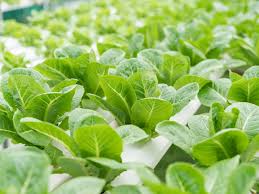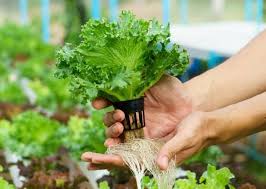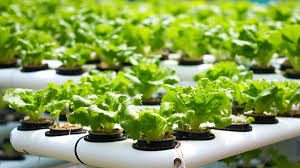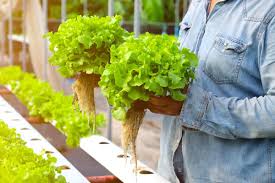Hydroponics is an innovative method of growing plants without soil, using nutrient-rich water solutions instead. This technique has gained immense popularity among both commercial growers and home gardening enthusiasts due to its ability to produce high-quality vegetables in a controlled environment.
The method is particularly appealing in urban areas where space is limited, making it possible to cultivate a variety of crops in small spaces, such as balconies or rooftops.
Hydroponic vegetables offer numerous advantages over traditional soil-based gardening, including faster growth rates, reduced water usage, and a lower risk of pests and diseases.
In hydroponic systems, plants are provided with all the essential nutrients they need for growth, allowing them to thrive without the constraints imposed by soil.
This method also enables growers to have precise control over the growing conditions, including pH levels, temperature, and nutrient concentrations. As a result, hydroponic vegetables can be produced year-round, regardless of external weather conditions.
This level of control not only leads to higher yields but also allows for the cultivation of a wider variety of crops, some of which may not typically grow well in certain climates or regions.
One of the most significant benefits of hydroponics is the ability to maximize space. Vertical farming, a popular technique within hydroponics, involves stacking plants in layers to utilize vertical space efficiently.
This method can significantly increase the number of plants grown per square foot compared to traditional farming methods. Additionally, hydroponics can be practiced indoors or outdoors, making it versatile for various settings.
Another advantage of hydroponic vegetables is their enhanced nutritional profile. Studies have shown that hydroponically grown crops can have higher nutrient content compared to their soil-grown counterparts. This is largely due to the precise delivery of nutrients directly to the plant roots, ensuring they receive what they need when they need it.
Furthermore, because hydroponics eliminates the need for pesticides and herbicides often used in conventional agriculture, the resulting vegetables are often cleaner and healthier.
The environmental benefits of hydroponic farming cannot be overlooked. This method uses significantly less water than traditional agriculture, as the closed-loop systems recirculate water, minimizing waste. Hydroponics also reduces the need for chemical fertilizers, as nutrients are directly supplied to the plants, leading to less runoff and pollution in local waterways.
As the demand for sustainable food production continues to rise, hydroponic vegetables have become an increasingly attractive option for meeting global food needs. With advancements in technology and growing interest in sustainable practices, hydroponics is poised to play a crucial role in the future of agriculture.
The world of hydroponics offers exciting opportunities for growing vegetables in an efficient and sustainable manner. From leafy greens to fruiting vegetables, a wide variety of crops can be successfully cultivated using hydroponic techniques.
Understanding the different types of hydroponic vegetables available, their unique growing requirements, and the systems best suited for their cultivation can empower gardeners and farmers to make informed choices in their growing endeavors.
As we explore the list of hydroponic vegetables, it becomes clear that this method not only enhances food security but also promotes a healthier, more sustainable way of living.
Benefits of Growing Hydroponic Vegetables

1. Space Efficiency: Hydroponic systems can be set up vertically, allowing for more plants to be grown in a smaller area compared to traditional soil gardening, making them ideal for urban settings.
2. Faster Growth Rates: Plants grown hydroponically often grow faster than those in soil due to the direct availability of nutrients and water, leading to quicker development and earlier harvests.
3. Water Conservation: Hydroponics uses significantly less water than traditional farming, as closed-loop systems recycle water, reducing waste and efficiently using resources, especially crucial in areas with water scarcity.
4. Reduced Pesticide Use: Hydroponic systems, often grown indoors or in controlled environments, experience less exposure to pests and diseases, decreasing the need for chemical pesticides and resulting in healthier vegetables.
5. Year-Round Production: Hydroponics allows for year-round cultivation, independent of external weather conditions, ensuring a consistent supply of fresh vegetables.
6. Better Control Over Growing Conditions: Hydroponic systems provide precise control over environmental factors like pH, temperature, and nutrient levels, resulting in optimal growing conditions and enhanced crop quality.
7. Cleaner Harvests: Since hydroponically grown vegetables do not come into contact with soil, they are generally cleaner and have fewer contaminants, making for easier cleaning and preparation.
Common Hydroponic Systems
1. Nutrient Film Technique (NFT): A thin film of nutrient-rich water flows over the roots of the plants, providing necessary nutrients and oxygen, making it efficient for growing leafy greens.
2. Deep Water Culture (DWC): Plants are suspended in a nutrient solution with their roots submerged, using an air pump to provide oxygen, making it easy to manage and effective for fast-growing vegetables.
3. Ebb and Flow (Flood and Drain): This system periodically floods the growing area with nutrient solution, then drains it back into a reservoir, providing water and nutrients while allowing oxygen to reach the roots.
4. Aeroponics: Plants are suspended in air, and their roots are misted with a nutrient solution, using minimal water and promoting rapid growth due to increased oxygen exposure, particularly effective for delicate plants.
5. Wick System: A passive hydroponic system using wicks to draw nutrient solution from a reservoir to the plant roots, easy to set up and suitable for beginners, although less efficient for larger plants.
6. Vertical Hydroponics: An innovative approach where plants are grown in vertical stacks, maximizing space and light exposure, popular for urban farming with high-density production.
Read Also: How to Improve Fertile Egg Survival Rate
Essential Nutrients for Hydroponic Vegetables

1. Macronutrients: Required in larger quantities, including:
i. Nitrogen (N): Essential for leaf growth and chlorophyll production, critical for photosynthesis.
ii. Phosphorus (P): Crucial for root development, flowering, and energy transfer within the plant.
iii. Potassium (K): Important for water regulation, enzyme activation, and improving fruit quality.
2. Secondary Nutrients: Needed in moderate amounts, including:
i. Calcium (Ca): Essential for cell wall structure and stability, important for root and shoot development.
ii. Magnesium (Mg): Vital for photosynthesis, helps regulate other nutrient functions, and is a key component of chlorophyll.
iii. Sulfur (S): Important for protein synthesis, chlorophyll production, and aids in enzyme and vitamin development.
3. Micronutrients: Required in trace amounts, including:
i. Iron (Fe): Essential for chlorophyll synthesis and electron transport in photosynthesis.
ii. Manganese (Mn): Involved in photosynthesis and nitrogen metabolism.
iii. Zinc (Zn): Important for enzyme function and protein synthesis, contributing to growth regulation.
4. Nutrient Solution: Commercial nutrient solutions are used to provide a balanced supply of essential nutrients, ensuring healthy plant growth.
5. pH Balance: Maintaining the right pH level (typically between 5.5 and 6.5) is critical for nutrient availability; regular monitoring and adjustment help ensure that plants can effectively absorb necessary nutrients.
Best Hydroponic Vegetables for Beginners
1. Lettuce: A popular choice for hydroponic systems due to its fast growth and minimal nutrient requirements; it thrives in various hydroponic methods, making it ideal for newcomers.
2. Spinach: Similar to lettuce, spinach grows quickly and easily in hydroponic systems; it’s nutrient-rich and can be harvested multiple times, providing continuous yields.
3. Kale: This hardy leafy green adapts well to hydroponics and offers high nutritional value; it grows rapidly and is resilient to different environmental conditions, making it suitable for beginners.
4. Swiss Chard: A colorful addition to hydroponic gardens, Swiss chard is easy to grow and can be harvested multiple times, offering both aesthetic appeal and nutritional benefits.
Read Also: 19 The Medicinal Health Benefits of Reishi Mushroom (Ganoderma lucidum)
Leafy Greens for Hydroponic Cultivation

1. Arugula: This peppery leafy green grows quickly and is well-suited for hydroponic systems; it can be harvested in as little as three weeks, making it an excellent choice for quick results.
2. Mustard Greens: Known for their distinct flavor, mustard greens thrive in hydroponic systems and can be harvested early for tender leaves or later for a more mature taste.
3. Bok Choy: A staple in Asian cuisine, bok choy grows efficiently in hydroponics; it prefers cooler temperatures and can be harvested at various stages for different culinary uses.
4. Watercress: A nutrient-dense leafy green, watercress grows well in hydroponic systems; it prefers a continuous flow of water, making it ideal for systems like Nutrient Film Technique (NFT).
Fruiting Vegetables in Hydroponics
1. Tomatoes: Tomatoes thrive in hydroponic systems and are relatively easy to grow; they require proper support and care but yield delicious fruits, making them a rewarding choice for beginners.
2. Peppers: Bell peppers and hot peppers can be successfully cultivated in hydroponics; they require similar conditions to tomatoes and provide a bountiful harvest.
3. Cucumbers: Fast-growing and prolific, cucumbers adapt well to hydroponic methods; they require vertical support as they grow, making them an exciting addition to a hydroponic garden.
4. Strawberries: While a bit more challenging, strawberries can be grown hydroponically; they need careful attention to nutrient levels and pH but reward growers with sweet, juicy fruits.
Herbs Suitable for Hydroponic Systems
1. Basil: A favorite among home cooks, basil grows quickly in hydroponic systems and can be harvested multiple times; it prefers warm temperatures and ample light.
2. Mint: Mint is easy to grow in hydroponics and offers a refreshing flavor for culinary uses; it’s a vigorous grower, so it’s essential to manage its spread in the system.
3. Parsley: This versatile herb thrives in hydroponics and can be used fresh or dried; it’s relatively low maintenance and can be harvested continuously.
4. Cilantro: Known for its distinct flavor, cilantro grows well in hydroponic systems; it has a shorter growing cycle and can be harvested quickly, making it a popular choice for beginners.
Seasonal Considerations for Hydroponic Vegetables
1. Light Availability: Seasonal changes in natural light can affect hydroponic growth; during shorter days in winter, supplementing with grow lights is crucial to ensure adequate light for photosynthesis.
2. Temperature Control: Maintaining optimal temperatures is essential for plant health; during summer, cooling systems may be needed, while heating might be necessary in colder months to provide a stable environment.
3. Humidity Levels: Seasonal humidity can impact plant growth; high humidity can lead to mold and mildew, while low humidity can cause plants to dry out, so monitoring and adjusting humidity levels is essential.
4. Nutrient Management: Different growth stages may require varying nutrient concentrations; seasonal shifts might necessitate adjusting nutrient formulas to match the changing demands of plants during different growth phases.
Troubleshooting Common Hydroponic Issues
1. Nutrient Deficiencies: Signs of nutrient deficiencies, such as yellowing leaves or stunted growth, can indicate an imbalance in the nutrient solution; regularly checking and adjusting the nutrient mix can prevent these issues.
2. pH Imbalance: An incorrect pH level can hinder nutrient uptake; regularly testing the water’s pH and adjusting it to the optimal range (usually between 5.5 and 6.5) is crucial for plant health.
3. Root Rot: Overwatering or poor drainage can lead to root rot; ensuring adequate oxygen supply and avoiding waterlogged conditions can help prevent this problem.
4. Pest Infestations: Pests can still affect hydroponic systems; regularly inspecting plants and implementing preventive measures, such as introducing beneficial insects or using organic pesticides, can manage pest populations.
Harvesting and Storing Hydroponic Vegetables
1. Timing for Harvest: Knowing the right time to harvest is essential for quality; most leafy greens can be harvested when they reach a certain size, while fruiting vegetables should be picked when fully ripe.
2. Harvesting Techniques: Using clean, sharp tools to cut plants helps prevent damage and disease; for leafy greens, snipping leaves at the base encourages further growth, while fruiting vegetables should be twisted off gently to avoid bruising.
3. Cleaning After Harvest: Washing vegetables gently after harvesting removes dirt and contaminants; it’s important to handle them carefully to maintain their quality and prevent damage.
4. Proper Storage Conditions: Storing harvested vegetables in a cool, dark place extends freshness; leafy greens benefit from being wrapped in damp paper towels and placed in perforated plastic bags, while fruits and vegetables should be stored according to their specific requirements to prevent spoilage.
Do you have any questions, suggestions, or contributions? If so, please feel free to use the comment box below to share your thoughts. We also encourage you to kindly share this information with others who might benefit from it. Since we can’t reach everyone at once, we truly appreciate your help in spreading the word. Thank you so much for your support and for sharing!
Read Also: How to Start an Urban Farm
Frequently Asked Questions
We will update this section soon.

